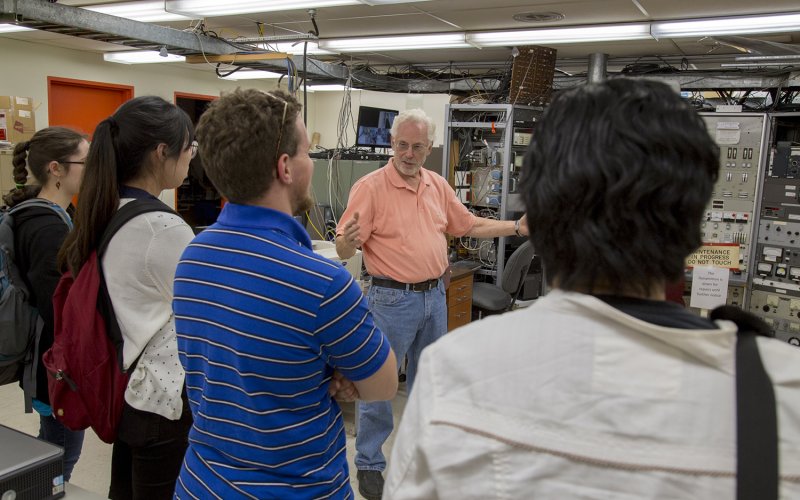Ion Beam Lab: 50 Years of Materials Research

ALBANY, N.Y. (Dec. 16, 2021) — Tucked between the Academic Podium and the State Quad parking lot on UAlbany’s Uptown Campus is a nondescript white building. Inside is an elevator that leads down to the SUNY Ion Beam Laboratory (IBL), a research facility designed to provide students, faculty and outside users with the necessary resources for state-of-the-art research, development, and education and training using high-energy particle (ion) accelerators.
Conceived and constructed by researchers in UAlbany’s Department of Physics in the 1960s, the project was initially designed to house neutron-based experiments. As such, it was built 20 feet underground with shielding designed with the safety of the University community in mind. Switching gears to accelerator technologies, which were deemed safer and more manageable, the Nuclear Accelerator Lab opened in 1970 under the direction of Professor Jagadish Garg of Physics.
"As early as the 1930s, there was a strong push by the U.S. government to fund research related to accelerators in order to investigate the structure of the atom," said former IBL assistant director Art Haberl, an engineer who came to UAlbany in 1969 and has helped build and manage the accelerators since the lab’s founding. "The research was still a priority when work began on the lab, but it became clear that the energy and safety requirements for neutron-based experiments were a bridge too far, but nuclear accelerator technology would be a perfect fit."
Over the course of the next 50 years, the lab has undergone several transformations. It first served as a catalyst for physics researchers on campus for atomic and nuclear research, before becoming one of the foremost destinations in the world for scientists looking to conduct accelerator-based experiments ranging from ion implantation through materials analysis and from low energies to several Mega electron-volts.
It also underwent a name change in the 1980s to better reflect the technological focus of the work and assuage any fears that UAlbany had a nuclear reactor under the parking lot (which it doesn't).
Instead, the renamed SUNY Ion Beam Laboratory is home to arguably the best collection of powerful ion beam instrumentation in the world. It is accessible to researchers in the academia, federal agencies and industry researchers.
The IBL offers beams of a wide variety of ions at energies as high as 4MeV and multiple experimental capabilities via six beamlines. These beams are used for studying the effects of ion irradiation or implantation on different semiconducting, organic and biological materials and surface modifications.
The laboratory has hosted researchers from different parts of the U.S. and Germany, France and China, among others. Universities in other countries, especially in China and Japan, have sought technical guidance from IBL staff in replicating some of its capabilities on their campus.
After celebrating 50 years in 2020, the Ion Beam Laboratory is embarking on expansion of its student training program by teaming, for example, with Hudson Valley Community College’s Gene F. Haas Center for Advanced Manufacturing Skills (CAMS).
Under this collaboration, HVCC students will manufacture components for the IBL. The components are then used in the IBL to maintain its two accelerators and multiple spectrometers. This serves both programs well: HVCC students gain valuable experience designing and building real-life components, and the IBL receives quality components to replace those that are nearing the end of their service.
"This symbiotic collaboration between the schools helps student success in science-based careers and supports scientific advances by enabling uninterrupted operations of the IBL," said Satyendra Kumar, director of the Ion Beam Laboratory and associate vice president for research at UAlbany. "The work will also help Hudson Valley students to feel empowered when they see something created by them being used in cutting-edge research at the Ion Beam Lab, and be more interested in research careers."
Such collaborations and commitment to IBL’s improvement and advancement are the hallmark of the IBL team. The collaborations also speak to the dedicated group of engineers, technicians and physicists who have helped the lab grow from its initial mission to serving as one of the few accelerator facilities capable of conducting a broad range of ion-beam based experiments.
This team includes Haberl and Wayne Skala, a lab technician who served as a key contributor in ensuring the electronics apparatus remained functional. Skala, who passed away in 2019, took over the role of assistant director of the lab following Haberl’s retirement.
In addition to Garg, past directors of IBL include Professor of Physics William Lanford, Distinguished Service Professor Hassaram Bakhru of SUNY Poly, and Distinguished Service Professor of Physics and former chair James Corbett, who passed away in 1994.
The Ion Beam Lab is currently managed by engineer Chris Righi, project manager Kevin Wynne and Kumar.




